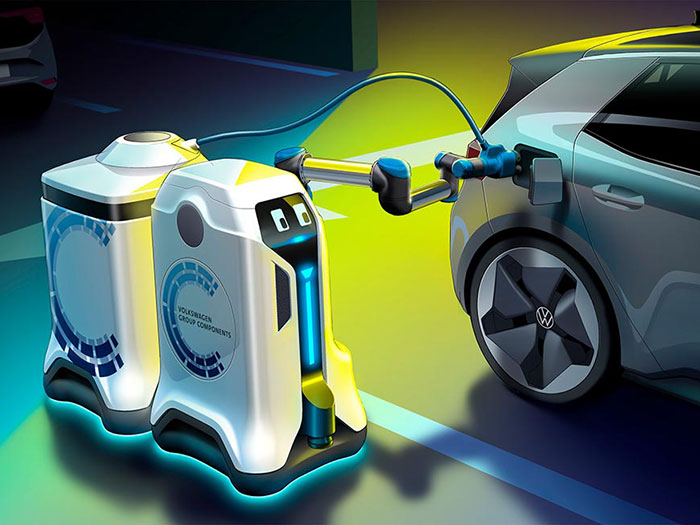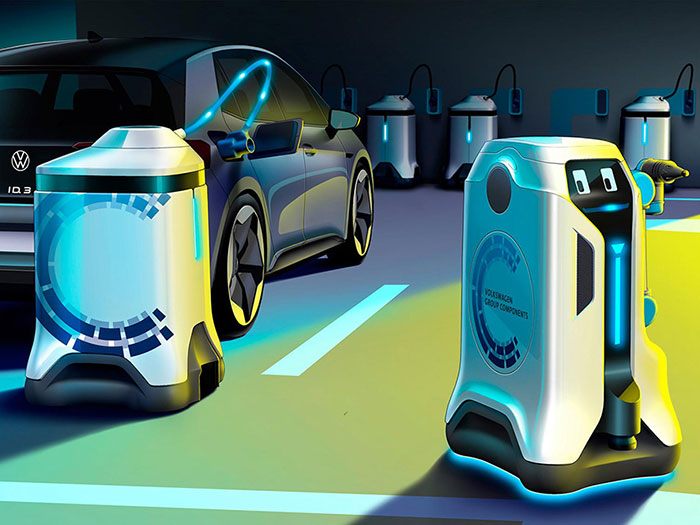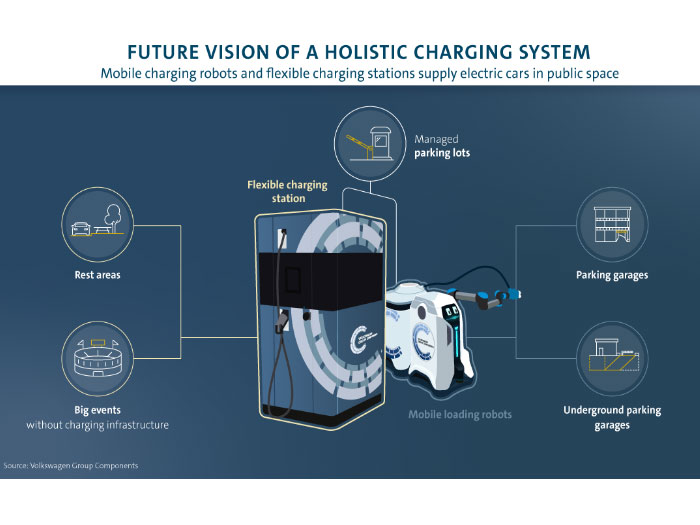Need to charge an electric car? Leave it to the mobile robot
Mobile robots that bring energy storage devices to electric vehicles and perform the entire charging operation with no human interaction - that’s Volkswagen Group Components’ visionary concept for turning every parking space into a charging point.
In the not too distant future, drivers of electric cars will no longer have to search for charging stations. Mobile charging robots will take over this task,driving to the electric car completely autonomously.
The service, which is the latest project from Volkswagen Group Components, can be started via app or from the vehicle itself using V2X communication. Once activated, the mobile robot drives itself to the vehicle that needs charging and communicates with it. It then opens the charging socket flap, connects the mobile energy storage device it has brought there and starts recharging. Once the service is complete, the robot decouples the storage device and brings it back to the charging station. All without any human interaction.
Intelligent robots and mobile energy

But how exactly does the system work? The mobile robot brings a trailer in the form of an energy storage device to the vehicle and connects them. During the charging process the robot performs various operations and charges other electric cars. Once the vehicle is fully charged, the robot collects the energy storage device and takes it back to the charging station, where it can be recharged and used again.
“The mobile charging robot will spark a revolution when it comes to charging in different parking facilities, such as multistorey car parks, parking spaces and underground car parks. We bring the charging infrastructure to the car and not the other way around, without any complex individual infrastructural measures”, summarises Mark Möller, Head of Development at Volkswagen Group Components.
A visionary prototype
“It’s a visionary prototype, which can be made into reality quite quickly, if the general conditions are right”, Möller continues. Volkswagen Group Components is researching different approaches for building charging infrastructure and has already developed several successful products, such as flexible quick charging stations and DC wall boxes. Customer-oriented, intelligent and flexible approaches to charging are at the centre of the research.
Battery wagons

The prototype consists of a compact, self-driving robot and agile energy storage devices, also known as battery wagons. They are equipped with an energy content of around 25 kWh each and DC quick charging of up to 50 kW.
The charging robots can move several battery wagons to where they are required at the same time. Thanks to in-built cameras, laser scanners and ultrasonic sensors, the robot recognises possible obstacles such as other vehicles and pedestrians and reacts to these, and can perform connection and decoupling operations with great precision. Depending on the size of the parking area, several autonomous charging robots can be employed simultaneously.
Making charging points flexible

The mobile charging robot can be put to use in various ways as electric car users can choose to park in any available space - whether a charging station is free or not. For operators of different parking facilities this is a quick and easy solution to electrify every parking space, without having to make costly investments.
“This approach has an enormous economic potential”, says Möller. “Construction work for charging stations as well as the costs for installing the charging infrastructure can be reduced considerably”. The compact design of the robot is also suited for use in underground car parks: “The problem of a charging station being blocked by another vehicle will no longer exist with our concept. You simply choose any parking space as usual”.
Volkswagen's commitment
Volkswagen Group is engaged in initiatives to establish a charging infrastructure at many levels. Together with its dealers, the company is installing a total of 36,000 charging points throughout Europe by 2025. A large proportion of these will be publicly available.
Volkswagen is also launching its own wallbox for home charging called the ID.Charger. And as a co-founder of the IONITY joint venture, it is participating in the installation of 400 fast-charging parks on major European highways. In a few years, charging an EV will be as easy as charging a smartphone.
Source: Volkswagen AG
